It’s one of your biggest frustrations as a blogger.
You hustle for every email address you collect. Guest posts, search engine optimization, giveaways, social media marketing…
You craft the perfect email, pack in a ton of value, and press the send button…
And CRASH. All that hard work you put in seems to come crumbling down.
Ahh, unsubscribes.
The online entrepreneur’s worst nightmare. And you’re right to be concerned. After all, when your subscribers hit that “unsubscribe” button, you’re literally losing money. Meaning your email unsubscribe rate is directly related to loss of money in your business.
If the lifetime value of of an email subscriber for your business is $500, that means when you send out an email and 60 people unsubscribe, you’re waving bye-bye to $30,000.

If that’s not a kick in the esophagus, I don’t know what is.
So does that mean you should just never email again? No! In fact, emailing too infrequently might be part of your problem (but we’ll get into that). Some unsubscribes are natural and expected.
But that doesn’t mean you should rest on your laurels and let those unsubscribes roll in. In this article, I’m going to show you 10 mistakes you may be making that encourage unsubscribers, and how to fix them so you can keep more money in your business.
Let’s do this thing.
Psst: There's actually an 11th mistake. It's the secret strategy some marketing experts use to decrease their email unsubscribe rates, increase engagement and get higher open, clickthrough and read rates. Click here to get the secret strategy.
Mistake #1: Your List is Disengaged
It’s a mistake most of us make at one point or another early in our online careers:
Focusing too much on vanity metrics.
Vanity metrics are any metric that can be measured but isn’t necessarily meaningful.
For example, traffic is largely a vanity metric. Traffic for the sake of traffic is not useful. You could have thousands of spam visitors a day and your numbers would look good, but they wouldn’t do anything for you.
It’s the engagement that matters. And that’s why sometimes the number of subscribers on your email list is just that: a vanity metric.
A disengaged list will unsubscribe at a higher rate than an engaged list. It makes sense, too: they’re just not interested in what you have to offer.
Before you jump to the conclusion that if they’re on your email list, they must be interested in what you have to offer, think about how you acquired your subscribers.
Maybe you hosted a giveaway for email subscribers and landed a lot of subscribers from that. Good strategy…
But maybe you gave away something like an iPad — something that’s appealing to everybody, and not just your target audience.

Those new subscribers aren’t going to all be engaged, since they only subscribed for the chance to win. They may not be even interested in your topic.
That means that every time you send an email, you’ll see unsubscribes in droves.
It also means that you’re paying for an email list that likely won’t earn much money.
This hurts even more, because your email subscribers cost you money to have on your list. If you’re paying for disengaged subscribers, you’re throwing money away.
In this case, the bad news is that it’s difficult to fix a disengaged list. You have to let those subscribers leave. The good news is that you can cull your list and stop paying for all those disengaged subscribers, leaving just the ones that are worth it on your list.
The Solution
Clean up your email list and delete disengaged subscribers — or even just encourage them to unsubscribe.
You can go through your inactive subscribers and send them an email to do just that.
Check out how Wave cleans up their email list with inactive accounts:
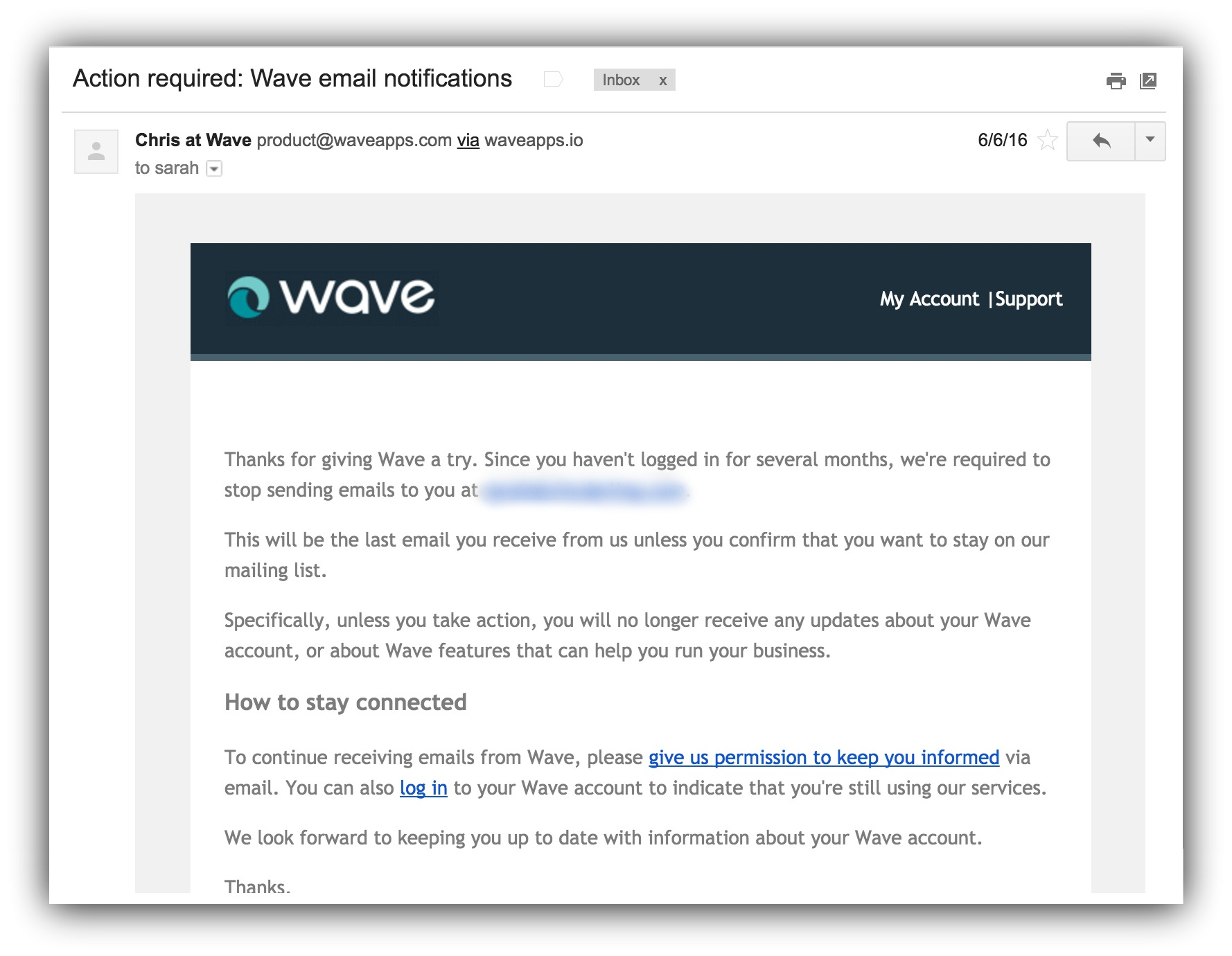
You’ll surely feel the pain of getting rid of a large number of subscribers — nothing hurts more than hustling hard for email subscribers and losing half of them in the blink of an eye.
However, this frees up your email list to enjoy normal open rates, clickthrough rates, and unsubscribe rates.
Mistake #2: You *Gasp* Make an Error
You know the saying “the shoemaker’s son always goes barefoot”?
It means that some professionals have a hard time applying their work to their own lives or businesses. And for writers, it’s extremely difficult to edit our own work.
In fact, three Sumos looked at this email before it was sent out, and it still sent with this error:
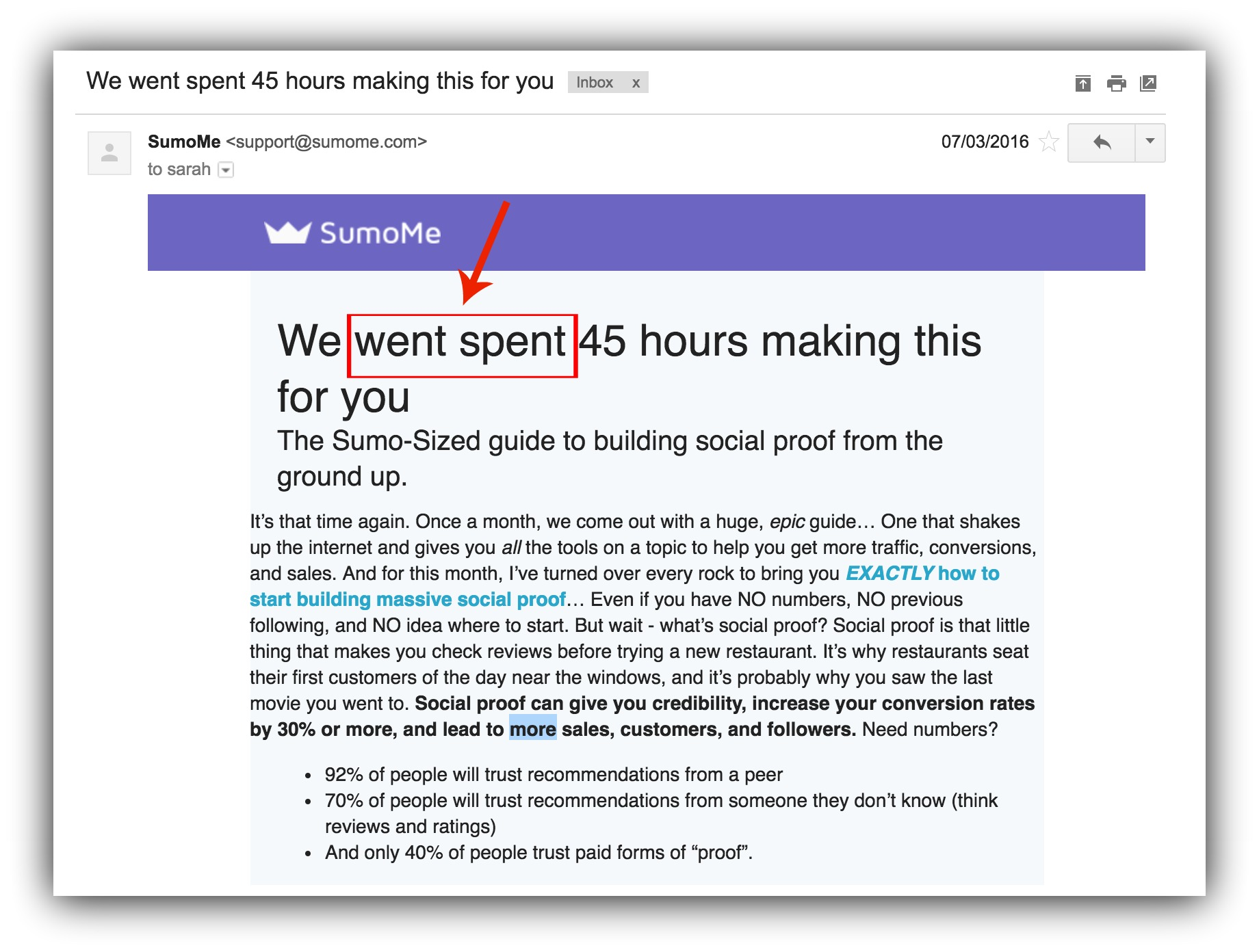
Falling into this trap, last year, I sent out an email to my list on Unsettle that had an error in it, to which I got an influx of unsubscribes, with one person commenting that my mistakes were unprofessional and I was wasting my subscribers time if I wasn’t willing to proofread my work.
Ouch.
Errors don’t have to just be spelling or grammar mistakes, either. Sometimes, you accidentally press “send” twice on your email or misquote a fact and all of a sudden your subscribers are leaving in droves.
Yup, people can be ruthless and unforgiving. Granted, accidents happen, and most subscribers will be understanding..
But some of them will flee faster than you can say “whoops”.
The Solution
If the error is something bigger, like sending out two emails or misquoting a date, all you can do is correct yourself and apologize.
Take a look how LoveBook apologized after their server “went a little bonkers” on their Facebook page:

Smaller errors should be easier to catch and prevent. Don’t rely on your own eye to edit your work, whether that be an email, an article or even a lengthy social media post.
Do as Tim Ferriss does and start an editing circle. Find a close, trusted group of friends to read your writing (you’ll read what they write too) and provide feedback, spot errors and fix your mistakes.
Protip: If you’re a Sumo Pro user, you may be able to find good candidates for this in our Facebook group.
Mistake #3: Your Emails Are Irrelevant
Here’s another saying you might have heard around the internet:
“The riches are in the niches.”
(That’s supposed to rhyme but doesn’t, because niche is pronounced like “neesh”, not “nitch”).
That’s because very few people are interested in the entire body of a topic.
On Unsettle, I write about doing work you love, focusing on small online businesses. I have some audience members who are interested in starting a blogging business, some interested in freelancing, and some in Etsy.
If I sent out an email to my entire list about how to get more Etsy sales, it would only be relevant to a segment of my list:

I’d alienate a huge portion of my subscribers.
Just because everybody on your list is interested in your niche or topic, doesn’t mean that they’re interested in everything about your niche.
To keep people around, your emails need to be highly relevant.
The Solution
Enter segmentation.
Segmentation is when you build your list based on your email subscriber’s interests within your niche so you can send them content that’s relevant to them, rather than keeping a big list with everybody and their dog in the same category.
You can see how I’ve segmented my list in the screenshot above. And the simplest way to do this is through your content upgrades.
If you were a food blogger and offer a content upgrade on a healthy recipe, subscribe those people to your “healthy” list, and send them only content that makes sense for them (no mac n’ cheese dishes, please!).
We do this on all of our articles. For example, on our Instagram Marketing guide, we’re communicating with the portion of our audience that is interested in social media (namely, Instagram):
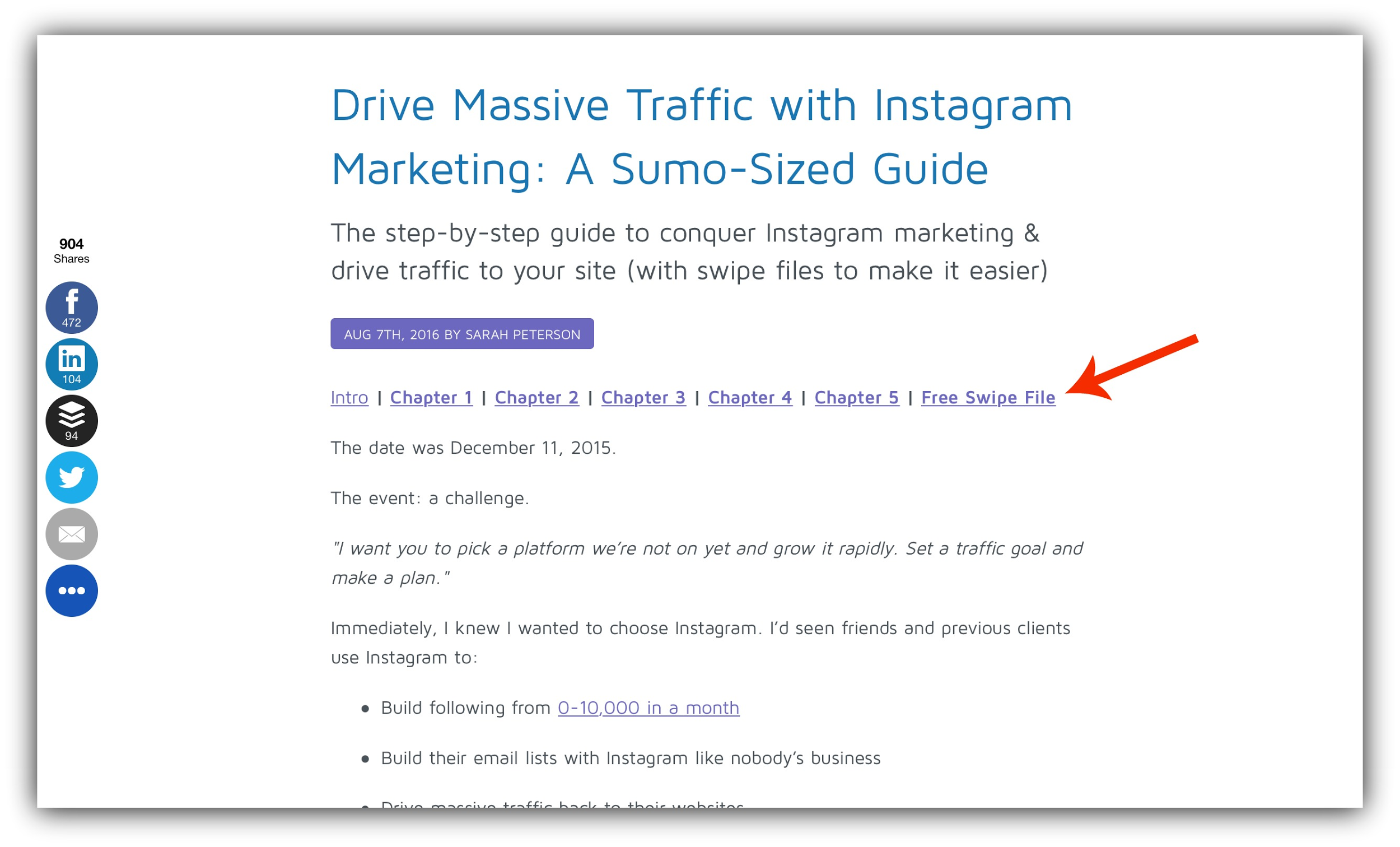
On that guide, we give away a content upgrade of a free swipe file that helps our readers set up an Instagram marketing plan, standard operating procedures for Instagram for their VAs, and more:
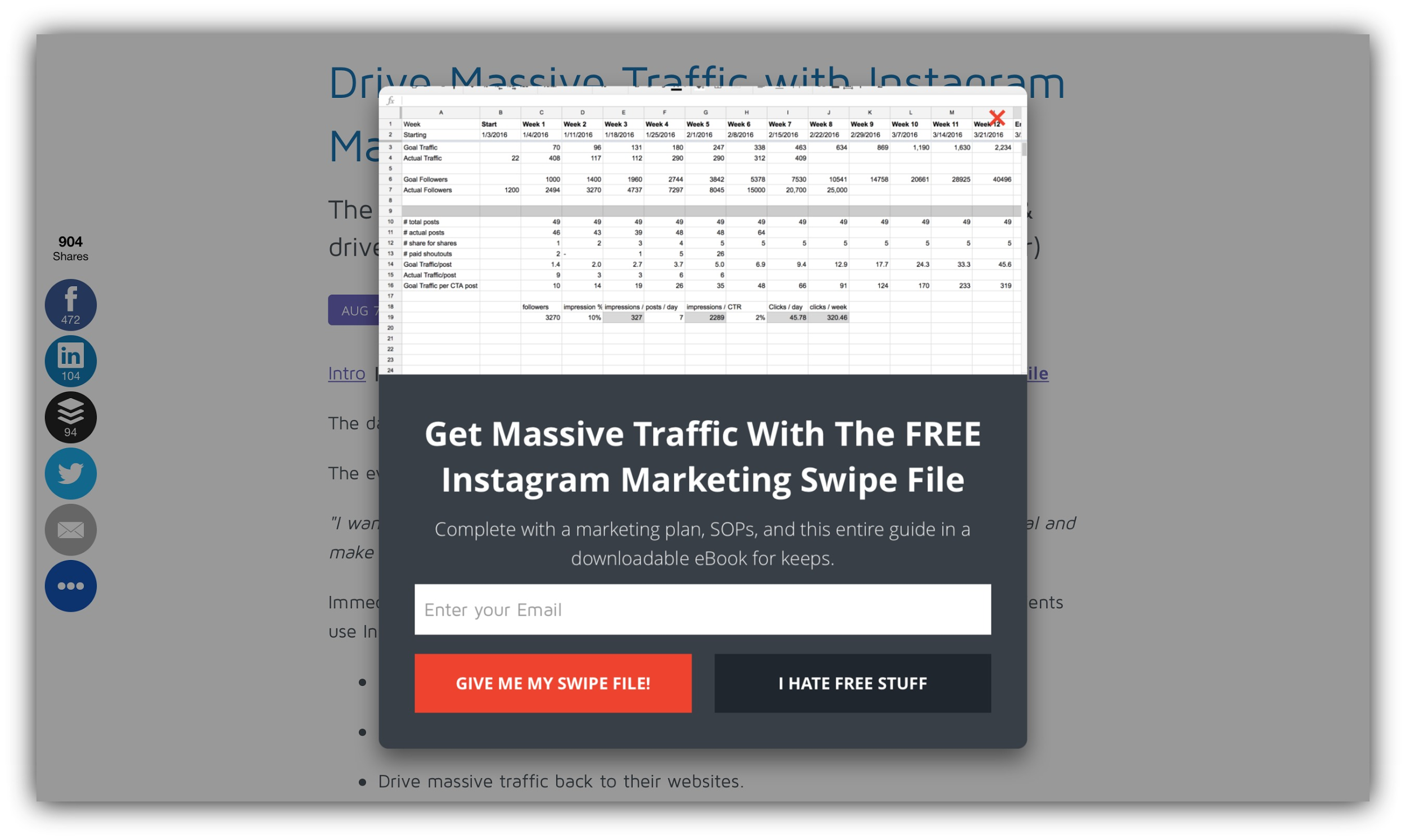
Not only does this Click Trigger convert at nearly 70%, but it also allows us to segment our list. We can assume that those who signed up for this content upgrade are interested in social media marketing.
Mistake #4: Your Email is Offensive
Controversy is good, right?
It elicits high-arousal emotion in your audience which leads to more shares and more potential for your thing to go viral… right?
While that may be the case, reliance on controversy is likely contributing to your high unsubscribes rate… especially if you’re crafting your message in an offensive way.
Sure, it’s possible that those people who unsubscribed aren’t “your people” anyway, but if you want to minimize your unsubscribes, you’ll do well to watch how you convey your messages — or avoid controversy completely.
There are exceptions to this. If controversy is part of your brand and a reason people are subscribing in the first place, you can’t kick that to the curb in favor of a lower unsubscribe rate.
For example, we’d be foolish to ask The Food Babe to avoid controversy in her emails. Her brand eats controversy for breakfast:
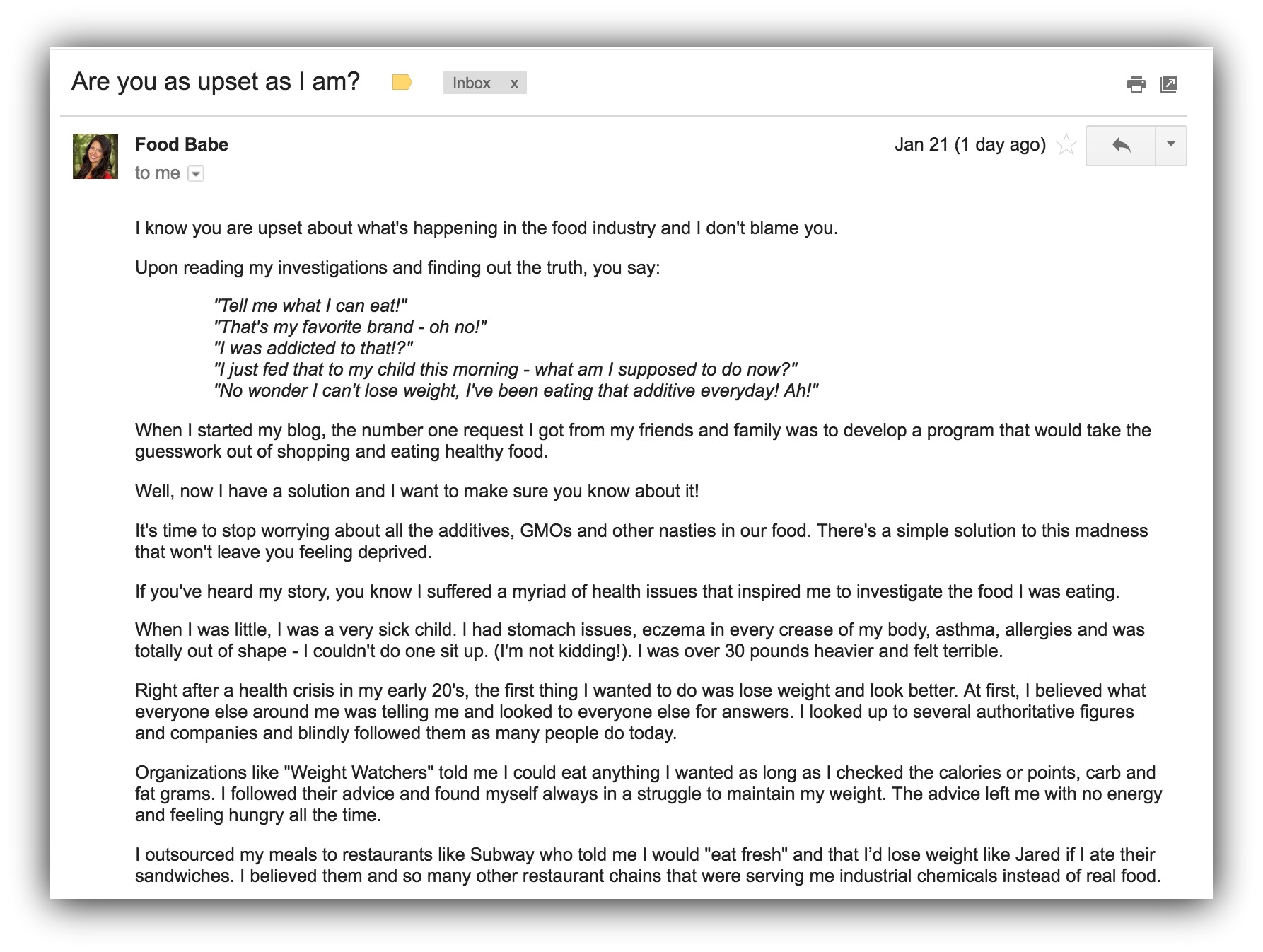
But if your business isn’t built on controversy, that doesn’t mean that you shouldn’t have a strong stance on anything. In fact, a strong stance is what makes the difference between building an audience of highly engaged, passionate people, and feeling as if your business lacks luster.
But the way you communicate that strong stance makes a difference.
The Solution
Don’t pull the plug on all controversy just because it might lead to unsubscribes. But do consider whether airing all of your controversial views to your email list is worth the loss of audience.
If it’s used in the email subject line controversy can greatly increase your email opens, but in the email itself, don’t burn your ships.
Brian Dean does well with controversial subject lines that are paired with a softer delivery:

You don’t have to get rid of controversy all together, just try not to be offensive.
Mistake #5: You Don’t Know What Your Audience Wants
Wouldn’t this be disappointing?
You set up your email autoresponder series. You spend a week whipping up a series of 15 high value emails that go out twice a week when your audience is the most engaged.
You even throw in a nice surprise for your audience — an unexpected freebie to help them overcome a challenge you anticipated.
And as these emails begin to send to your list, your unsubscribes skyrocket. People are leaving faster than you can say “last call” at your favorite dive bar.
Womp womp.
So what’s the matter? Why are people bouncing so quickly?
It’s because you don’t know what your audience wants.
You might think you know what they want. And you probably spent that entire week writing emails that you thought would resonate with your audience.
But all that time was wasted because you didn’t ask first.
The Solution
If you’re subscribed to many newsletters, you might see one email marketing trend that people seem to follow crop up in your inbox regularly: the “helping” email.
This is an email that asks your subscribers what they want to know about and how you can help them. You can do this through a survey or even just a simple question.
Check out how Bryan Harris from Video Fruit does this in his email sequence:

Adding one of these emails to your autoresponder series (hopefully at the beginning of your series!) before you create your other emails can be life saving. They help you get to know your audience so you can give them information they want — and impress them every single time.
Think you have a small list so nobody will answer? You might be surprised as to how many people do answer.
Mistake #6: You’re Emailing Too Frequently
I had a friend who signed up for an email list in my niche.
The newsletter he signed up for was one of a relatively popular blog’s and he was enjoying the emails at first.
But he began to get frustrated.
Why? Every day, he’d check his email and see yet another email from this blogger. He’d send me screenshots of the sheer volume of emails, and if he went a few days without checking his email, his inbox was littered with them.
Obviously, he unsubscribed.
Some brands can get away with emailing every day. For example, HARO (Help a Reporter Out) is a service that relies on emailing every day to get you press.
But yours probably isn’t one of them.
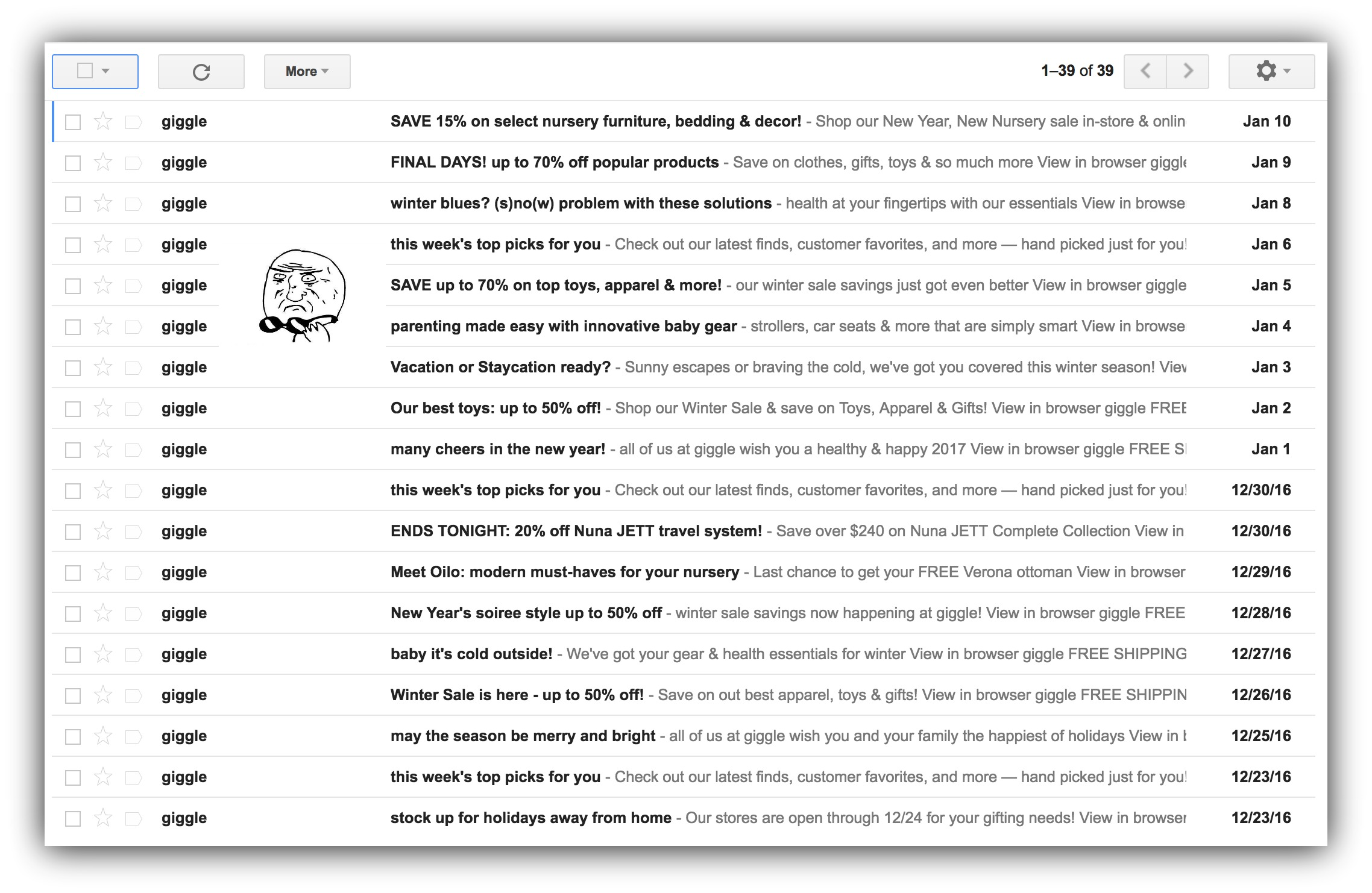
Giggle is not one of the brands who could, so I unsubscribed.
If your subscribers don’t rely on daily emails from you or if your emails aren’t time sensitive (like a promotion) cool it.
The Solution
Instead of emailing every day, email only when your list is engaging with their inbox.
Use the stats your email service provider give you to determine which days lead to the most opens, clicks, and likes. Then, email out on those days.
Remember from email marketing psychology — at first, you need to show up in your subscriber's inbox more frequently. This triggers the “Mere Exposure Effect”, getting your subscribers familiar with you initially.
But after the first week or two with your subscribers, you don’t need to email more than a couple of times per week.
Protip: If once a day is too much, more than once a day is spammy. That means mapping out your broadcast emails vs. your autoresponder emails and being intentional with when you press “send!”.
Mistake #7: You Let Your List Go Stale
Have you ever gotten an unsubscribe notification like this?
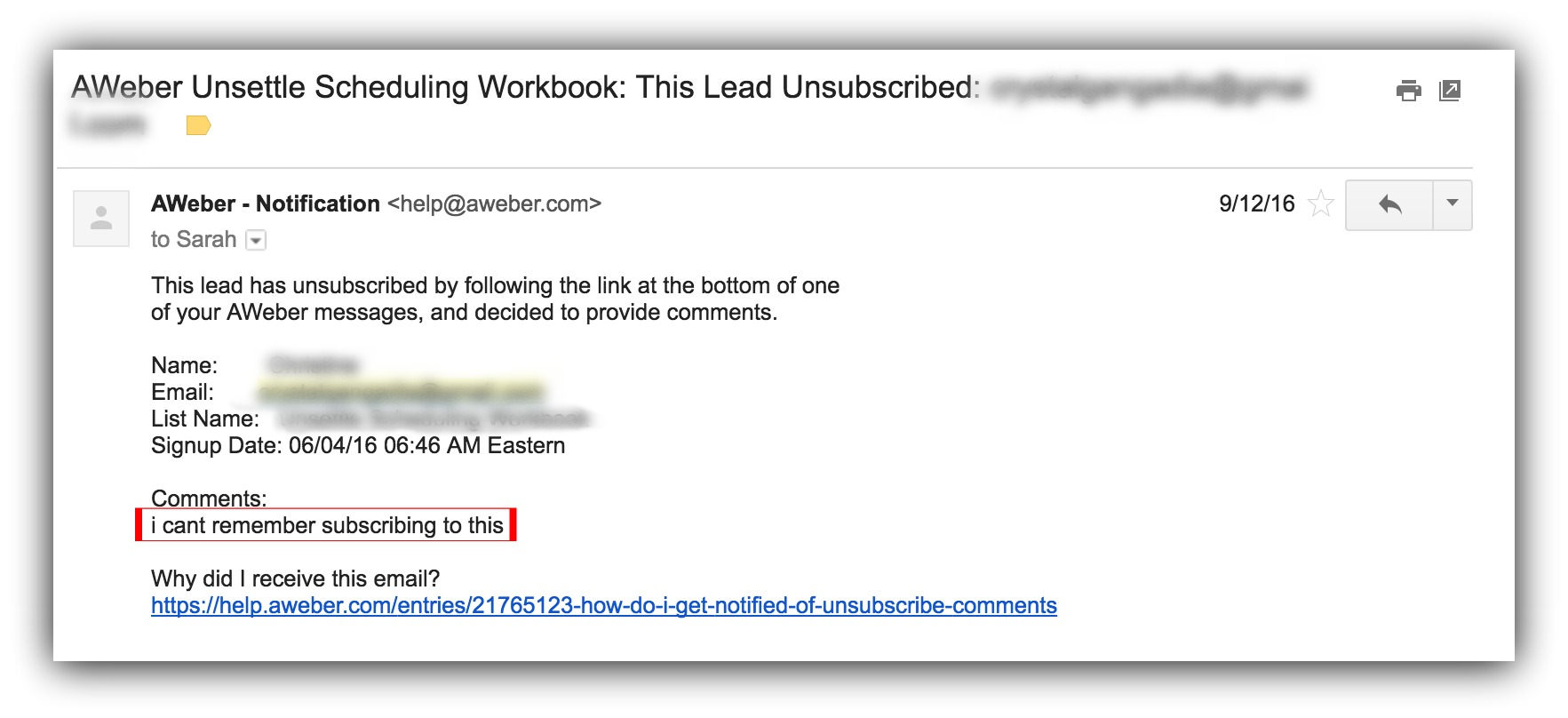
You probably didn’t steal the person’s email address, paste it into your email service provider and start spamming them.
You’re not that shady.
Chances are, they did subscribe to your email list. They just don’t remember it. You still may be to blame, though.
See, we’re a forgetful race.
I was telling my team that I forgot a word the other day, and I forgot the word that I had forgotten. No joke.
So, if you collected email addresses through a freebie, giveaway, or guest post and then stop communicating with them after your initial contact, people are going to forget who you are.
You let your list go stale.
Sometimes, there’s a good reason for this. For example, maybe you decided to take a break from your online business, or pivot and find a new focus. Or maybe you’re writing a new email sales sequence, or in the trenches with a product launch.
Whatever your reason for your stale list, it’s going to result in a lot more unsubscribers.
The Solution
Your list went stale because you stopped sending emails to them. To send emails to your subscribers, you don’t need to sit down at your computer every week and think of something to send.
You just need to set up an autoresponder series.
Instead of relying on all that extra time and energy you have (LOL) to create email content, get off the content creation treadmill and schedule your messages to go out to your list… no matter when your subscribers signed up.
Mistake #8: Your Emails Are Too Aggressive
I know this might seem to counter the typical advice out there about being clear, going for what you want and not stopping until you get it, but…
It’s possible that your subscribers are leaving because you’re coming off a bit too strong.
Every time you include a call to action in an email, you’re asking your subscribers to do you a favor. Gary Vaynerchuk dubbed the idea of “jab, jab, jab, right hook”.
In this scenario, the “jabs” are value-adds. Meaning that you’re building a relationship with your audience by adding value to their lives in your topic. Only after you’ve “jabbed” them a few times can you “right hook” them — or ask them for something (the sale, for example).
If you’re asking for favors right out of the gate without compelling your audience to do those favors for you, that’s just aggressive, brah.
At least take them to dinner first.
The Solution
I’m just going to come out and say it: some people will unsubscribe simply because you have something for sale. It doesn’t matter how much value you’d given them previously.
You don’t need those people anyway.
But most people will only get mad and unsubscribe if you’re asking for favors (the sale, a big call to action) without building a relationship with them first.
So take the time to build a relationship with your audience before selling to them in your emails. Do this with no-strings-attached, high value emails, like Noah does with OkDork:
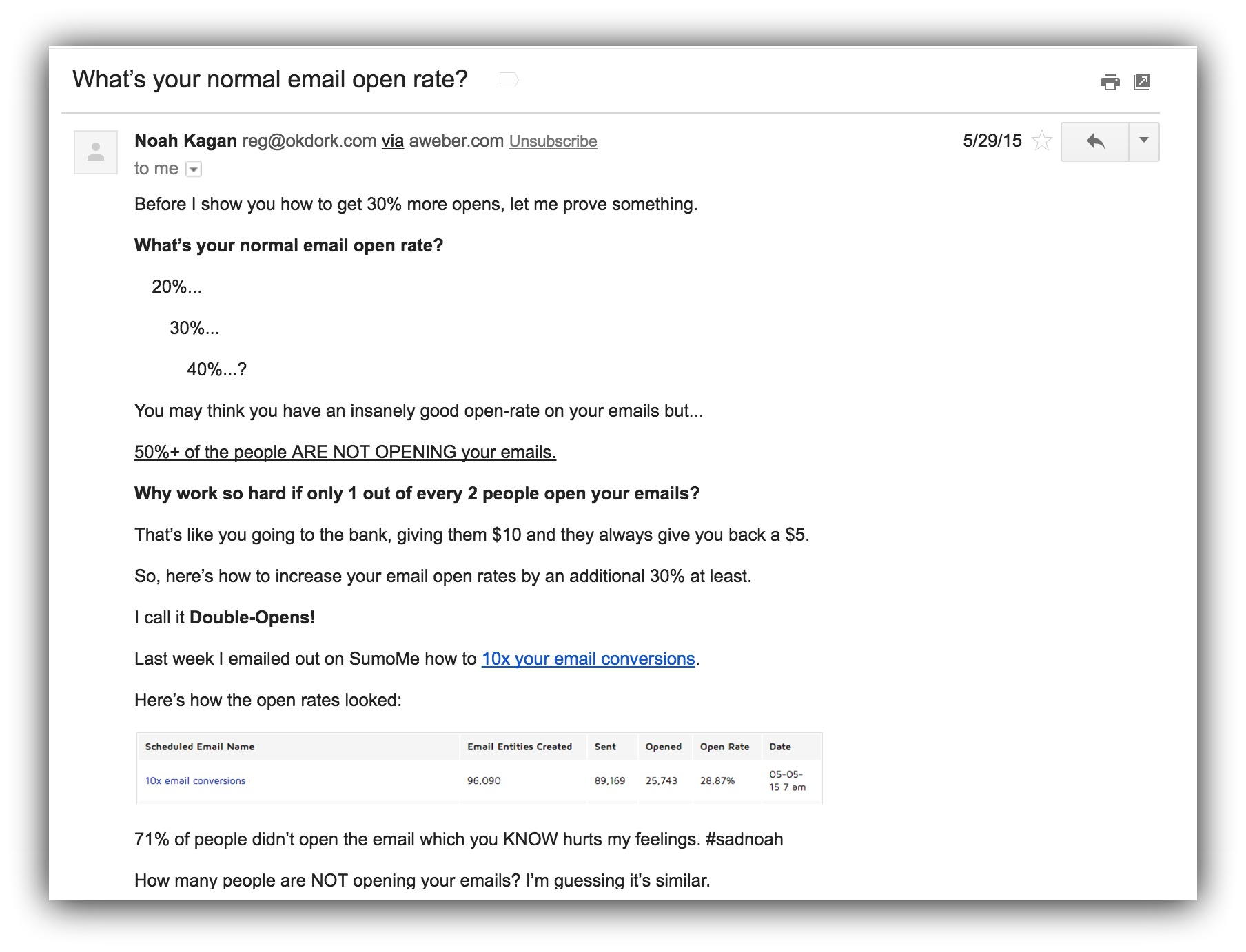
A helpful, quick-win email that provides value without expecting anything in return.
Send emails that foster trust and provide massive value. And do this before you bother selling or asking your subscribers for anything.
Mistake #9: Your Emails Aren’t Mobile Friendly
Ever open an email on your phone that just won’t work?
The email stretches out your screen, the images load slowly (or not at all) and the buttons aren’t clickable?
I don’t know about you, but this always happens to me when I really need the email to work (like when I’m trying to retrieve my boarding pass from email to get on a flight I’m almost missing).
For the impatient browser of 2017, that’s enough to click the unsubscribe button fast.
If you chose an email template that jumbles your words together and makes it difficult to read (let alone look at) on mobile, nobody’s sticking around.
Since 53% of emails are opened on mobile, it’s irresponsible to ignore how your emails look on mobile.
The Solution
Before you schedule a broadcast or press the “send” button to your list, send a test email to your inbox…
And check it on your phone.
Does it look okay? Great. You’re good to go.
Does it look wonky? Then change your template, remove some photos, or make the changes you need to to make sure it looks great on mobile.
And if no matter what you do your emails are showing up wonky, check your email service provider.
The top email service providers (Aweber, MailChimp, Constant Contact, ConvertKit, InfusionSoft) all have mobile friendly email templates. If yours doesn’t, seriously consider switching.
Mistake #10: You’re Not Using a Double Opt-in
What’s better…
Having a dead email on your list and paying for them until you lose them, or never having that dead email to begin with?
I think the latter. Here’s what I mean…
If you automatically sign your new subscribers up for your email list without having them confirm their email addresses when they sign up, you’re going to experience a much higher unsubscribe rate.
Having email subscribers confirm their subscription before adding them to your email list is called a double opt-in.
This cuts back on unsubscribes by making sure that the email addresses are legit. If somebody:
- Enters a fake email to get a freebie or
- Mistypes their email address or
- Signs up a friend or family member against their will
They’ll either never get your confirmation email or never confirm their subscription. This is a good thing for your unsubscribe rate, because they’ll never be added to your list.
When you send your next email, those who were added to your list by default of a single opt-in process will be unsubscribed by your email service provider because the email will have bounced.
Nerd Fitness gets it:
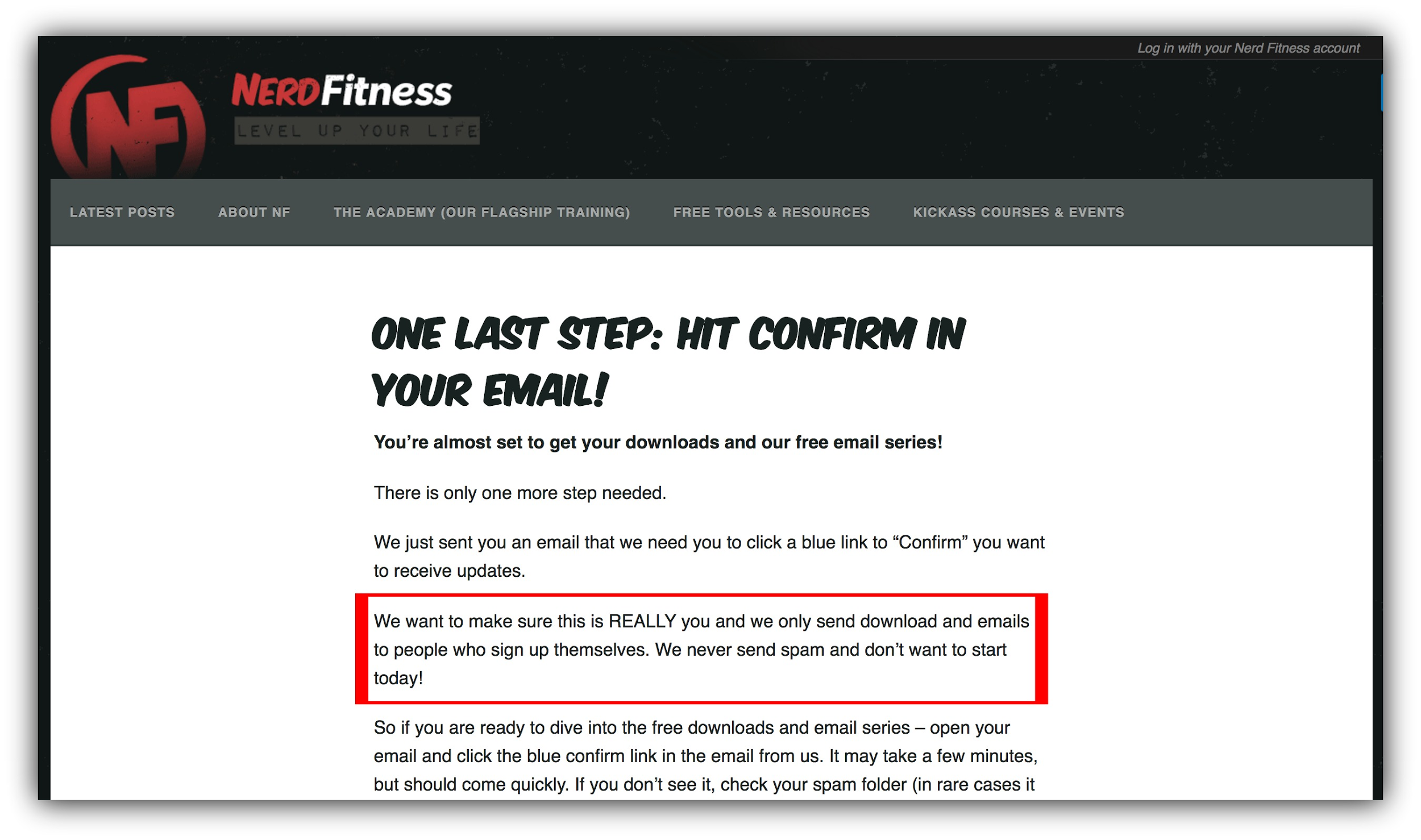
This does cut your email list back by a significant amount. And I get it. Using a double opt-in is like saying “Are you sure?… No seriously, are you really sure?” when somebody wants to join your email list. But it’s still a good idea.
The Solution
For the love of all that is good in the world, please activate your double opt-in.
There are a ton of good reasons to activate a double opt-in process other than your unsubscribe rate. Unless you’re a large company, you have no reason to not do this. It saves you money and heartache and instills goodwill.
If you’ve never touched your confirmation settings, chances are you already have it activated. Most email service providers do this as a default. The email will look something like this:
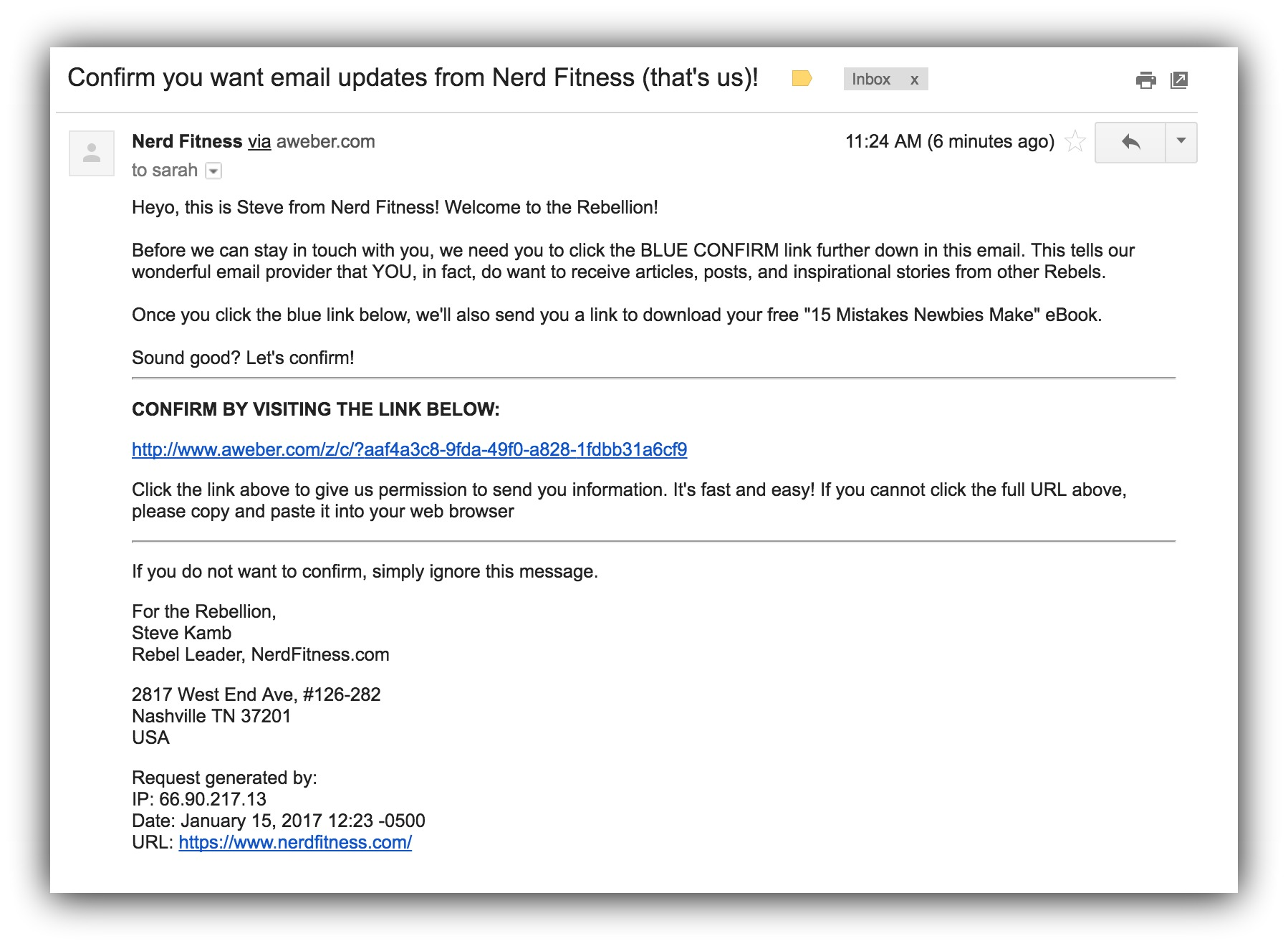
You can personalize it and encourage people to confirm their subscription on your thank you page like Nerd Fitness does, just make sure you have it activated.
Stop Costing Yourself Valuable Email Subscribers
It’s true that some unsubscribes are inevitable. They’ll happen with every email you send out.
But the last thing you want to do is lose leads who have the potential to be valuable, engaged members of your online community just because you were making a few preventable mistakes.
That’s like taking a stack of $100s from the ATM and lighting them on fire.
If you just read this 3,000+ word guide and don’t know where to start, here’s how I recommend tackling these:
Step 1: Ensure you’re getting your subscribers to confirm their email addresses (Mistake #10)
Step 2: Write a simple “helping” email and add it to your autoresponder (Mistake #5)
Step 3: Review your emailing frequency. If you’re emailing more than a few times a week, or less than once every couple of weeks, look at when your subscribers are opening email most often and adjust.
Step 4: Start going through the rest of the mistakes once you have a handle on these three.
Step 5: Profit.
Psst: There's actually an 11th mistake. It's the secret strategy some marketing experts use to decrease their email unsubscribe rates, increase engagement and get higher open, clickthrough and read rates. Click here to get the secret strategy.
Add A Comment
VIEW THE COMMENTS